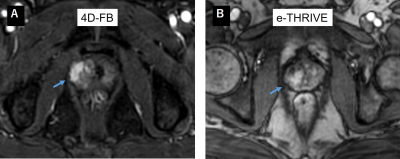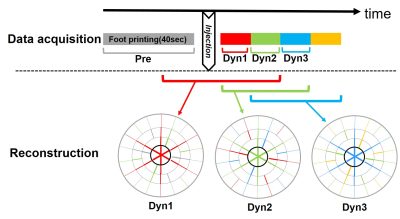Shintaro Horii1, Yoshiko Ueno2, Yuichiro Somia1, Ryuji Shimada1, Keitaro Sofue2, Yasuyo Urase2, Wakiko Tani1, Yu Ueda3, Akiko Kusaka1, and Takamichi Murakami2
1Center for Radiology and Radiation Oncology, Kobe University Hospital, kobe, Japan, 2Department of Radiology, Kobe University Graduate School of Medicine, Kobe University Hospital, kobe, Japan, 3Philips Japan MR Clinical Science, tokyo, Japan
1Center for Radiology and Radiation Oncology, Kobe University Hospital, kobe, Japan, 2Department of Radiology, Kobe University Graduate School of Medicine, Kobe University Hospital, kobe, Japan, 3Philips Japan MR Clinical Science, tokyo, Japan
The
k-space weighted image contrast reconstruction with variable-density golden
angle stack-of-stars acquisition may improve image quality of high temporal
resolution DCE-MRI compared to e-THRIVE, with keeping effective pharmacokinetic
information in PCa assessment.

Figure.3
Clinical dynamic contrast enhanced images of 4D-FB and e-THRIVE
A.
77-year-old patient with a Gleason 7 prostate cancer, initial PSA of 4.7 ng/mL.
Early dynamic contrast enhanced image (4D-FB) shows intense enhancement in the
region of the right peripheral zone (arrow). B. 66-year-old patient with a
Gleason 7 prostate cancer, initial PSA of 8.1 ng/mL.
Early dynamic contrast enhanced image (e-THRIVE) shows enhancement in the
region of the right peripheral zone (arrow).
